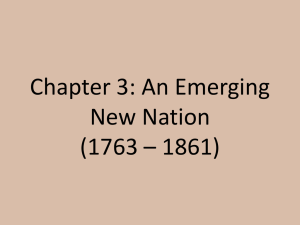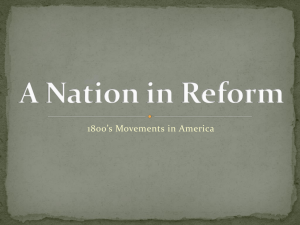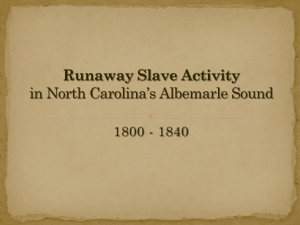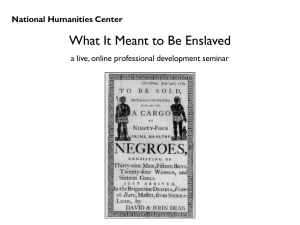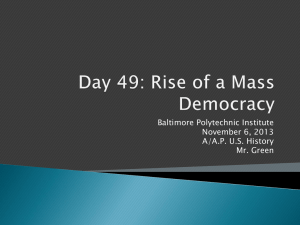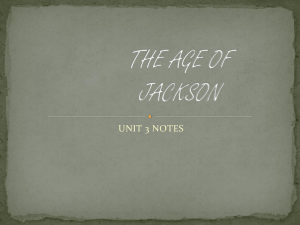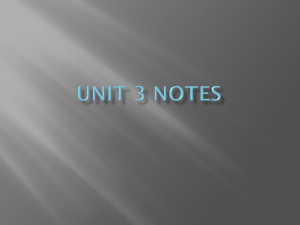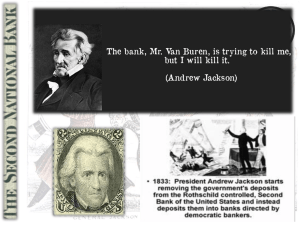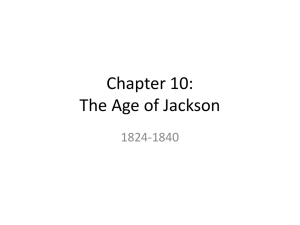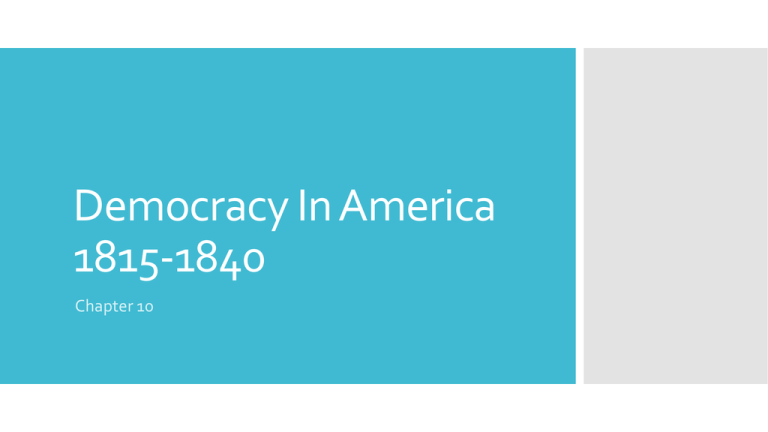
Democracy In America
1815-1840
Chapter 10
The Triumph of
Democracy
Property and
Democracy
Challenges to property qualifications for voting began
after revolution. Before 1790- they were common, but
not one state that entered the union under the new
Constitution used them.
One by one, the original 13 states got rid of them by
1860 (except for a curious hold out- RI – more on that in
a moment)
If the hallmark of citizenship was the right to vote,
there were now very few (white) men denied that
privilege, a reflection of the importance of
Individualism in the American character.
By 1840 90% of Adult white men could vote. Politics
was boisterous, Partisan, and sometime violent. In a
heterogeneous (many cultures)nation, democratic
political institutions were a big part of nationalism
The Dorr War
In order to vote in RI a person still needed to own
property valued at $134 or rent property for at least $7
a year – which disqualified many factory workers
In 1841 a group of people who wanted reform got
together and drafted a new state constitution, which
gave universal suffrage to white men. They hosted an
“extralegal” (which is a cute way of saying without
official permission- or illegal) referendum (vote of the
people on a law) and proclaimed Thomas Dorr (lawyer
who wrote the constitution) the governor. He was
arrested and served 2 years for treason.
Shows how seriously people took the “right” to vote
RI eliminated property qualification for native born
men, kept it for immigrants until 1888 (nativism)
Toqueville on
Democracy
Alexis de Tocquville was a French writer who visited/toured
America throughout 1830 (originally to study prisons and
prison reform), then went home and wrote Democracy in
America published in 1833.
He said that democracy is a “habit of the heart” meaning far
more than the right to vote or a set of political institutions.
According to De Tocquville; American culture encouraged
initiative, believed in equality, and an active public sphere
populated by organizations to improve society
The founders had been worried about too much democracy
(that’s why we have the electoral college) but political
participation triumphed during the age of Jackson- it was
the emblem of citizenship- and the “true mark of a free
man”
The
Information
Revolution
There was an explosion of printing during the early
1800s – the rise of the mass circulation “penny press”
(rather than the tradition 6 cents) so that by 1840 the
17 million people of the US read more newspapers than
the 233 million of Europe
Sensationalist journalism was born with the New York
Sun and New York Herald (the 1st “tabloids”) full of
crime stories and scandals. Political parties published
their own papers, as well as “alternative” groups like
abolitionists (the liberator) and early labor
organizations.
Women were frequent contributors to many papers,
not only with guides to domestic life, but poems,
essays, and passionate appeals about reform and
religious movements (more later)
The Limits of
Democracy
America in the early 1800s was both expansive and
exclusive. Even as new segments of the population gained
access to democratic institutions others were being
deliberately excluded.
For women and free African Americans, there was an
assumption of inferiority of both intellect and ability. “How
did women 1st become subject to man as she now is all over
the world? By her nature, her sex, just as the negro is, and
always will be, to the end of time, inferior to the white race
and therefore doomed to subjection”.
Women would gain the vote in 1920, the 15th Amendment
will be passed in 1870, but not until the voting rights act of
1965 will African American voting rights be protected in all
states
A Racial
Democracy
In contrast to European Hierarchy, Americans of
various classes dressed the same, travelled in the same
RR cars, and stayed in the same hotels.
In our nation- it was race that kept a human from being
able to participate in society, not wealth
Racist imagery and stereotypes are already well
established in early 1800s, African Americans were
portrayed as stupid and/or dishonest, or happy
superstitious slaves – and they had what they thought
of as “scientific” proofs to go with it.
Before 1800 Northern states did not forbid Blacks from
voting- though states that entered the union after that
did (Maine exception)
By 1860- blacks could only vote in 5 New England
states (in some cases with property qualifications) and
less than 4% of the Nations FREE black population
could vote.
Race and Class
In this “Age of Democracy”, the definition of the
political nation had become tied to race.
Blacks were aliens, not really Americans (much like
Indians) The could not serve in Army or militias, testify
in court, vote (generally) or attend pubic schools.
B/c there were so many different “types” of whites,
having African Americans as the “others” in society
helped solidify a sense of national identity.
The American
System
The War of 1812 significantly jumpstarted Americani
industry- after all- we didn’t have a choice. But the end
of the war brought renewed competition from British
manufacturers.
Henry Clay (and John C Calhoun) believed strongly that
the government should provide protection for the
American economy- and got President Madison on
board (for a while)
Proposed: A new National Bank (1st bank’s charter
expired 1811) a increased tariff, and the building of
roads and canals to help commerce (funded by tariff)
Controversial b/c it raised strict vs. loose construction
issues again.- which made Madison change his mind
partway through.
2nd Bank of US chartered 1816, Tariff of 1816 offered
protection to American goods, but no to
improvements- until civil war internal improvements
built by states or private companies
Banks and
Money
Lack of a bank during the war had been a problem for
US- local banks issues their own paper currency, which
devalued and hurt war effort
Went through in 1816 (even Jefferson supported)- with
another 20 year charter and 3.5x more capital than 1st
bank.
Controversial b/c it was a private business as well as the
government’s financial agent. Could issue $$- it was
supposed to regulate the supply of paper currency in
circulation to make sure it was backed by Specie (gold
and silver deposits), pay gov’t debts, and collect taxes.
Critics condemned b/c it was more accountable to it’s
investors than to the people – and it had a bad
tendency to get involved in land speculation ……
The Panic of
1819
1st fiscal crisis since beginning of nation (have had econ
probs, but this is more about cash flow) From this time
forward we’ll have one about every 20 years until great
depression- it’s a capitalism thing….thanks Adam
Smith
Caused by
End of war created huge demand in Eng for US
cotton
Land speculation (for cotton lands)- banks put out
too many risky loans- many of which end in
foreclosure
Results of
Rekindling political hostilities- est between West
(the farmers) who come to distrust National Bank
and East (the bankers) who think farmers are
greedy
Gov’t steps in and make getting western land
easier (by the civil war they are giving it away!)
Didn’t last very long- but caused BIG stress. Those
suffering in the downturn demanded help from state
and national government (this is a new thing)
The Politics of
the Panic
Western States, where Panic was worst, flooded their
own paper $$ in so people could pay back debts (which
would make citizens happy, but not really help $$
issues)
Made ordinary people “suspicious” of banks –
especially the Bank of US, leading to another landmark
supreme court case….
State of Maryland- which doesn’t like the National Bank
passed a law taxing the Baltimore branch- which they hope
will destroy it, and challenging its constitutionality.
Branch refuses to pay- so state sues manager- James
McCulloch for failure to pay taxes
McCulloch v
Maryland
Supreme Court dismissed charges against McCulloch, and
goes to the heart- is the bank Constitutional. Chief Justice
Marshall (the last federalist…) says yes it is- and says the
states cannot tax the federal government (est. the
supremacy of Fed over State)
Significantly increased the power of the federal government
over the states – which is a big argument at the time- and
Marshall hammers it until the Dem Reps are on board
Checked the excesses of the popularly elected state
legislatures, and puts limits on democracy at a time when
democracy is growing significantly (age of Jackson) keeping
it from running wild.
The Missouri
Controversy
James Monroe is the last of the “Virginia Dynasty” and
the last “founding father” (he was at Const.
Convention) to serve as president
Federalists are done- they ran their last candidate
(Rufus King) in 1816- cease to function as an opposition
party . When Monroe Runs for Re-election in 1820, he is
virtually unopposed, but one elector refused to vote for
him b/c he wanted GW to be only unanimous president
4 of 5 presidents had been from Virginia- governed 32
of 36 years of the republic
Period from 1816-1824 known as “Era of Good
Feelings” b/c there is strong nationalism and Dem-Reps
are the only political game in town. But the title is
deceptive, as there were serious issues lurking under
the surface – Especially Sectionalism
Presidential Rankings: C-Span Survey, 2009
1.
2.
3.
4.
5.
6.
7.
8.
9.
10.
11.
12.
13.
14.
Abraham Lincoln
Franklin Roosevelt
George Washington
Theodore Roosevelt
Harry Truman
John Kennedy
Thomas Jefferson
Dwight Eisenhower
Woodrow Wilson
Ronald Reagan
Lyndon Johnson
James Polk
Andrew Jackson
James Monroe
15.
16.
17.
18.
19.
20.
21.
22.
23.
24.
25.
26.
27.
28.
Bill Clinton
William McKinley
John Adams
George H.W. Bush
John Quincy Adams
James Madison
Grover Cleveland
Gerald Ford
Ulysses Grant
William Taft
Jimmy Carter
Calvin Coolidge
Richard Nixon
James Garfield
29. Zachary Taylor
30. Benjamin Harrison
31. Martin Van Buren
32. Chester Arthur
33. Rutherford Hayes
34. Herbert Hoover
35. John Tyler
36. George W. Bush
37. Millard Fillmore
38. Warren Harding
39. William Harrison
40. Franklin Pierce
41. Andrew Johnson
42. James Buchanan
One way to balance sectional tensions was to
ensure that there was an equal number of slave
and free states
1819 Missouri applied for addition to the Union
as a slave state- and Missouri is farther north
than any other slave area (on same latitude as IL
and IN)
Northern states propose Tallmadge
Amendment: saying no more slaves brought to
MO, and gradual emancipation of those thereSouth goes NUTS
Jesse Thomas /Henry Clay Compromise offer
compromise: Balance with Maine as a free state,
and no more slavery north of 36 30 line.
“Balance” becomes policy for 34 years (until K-N
Act in 1854) Slavery becomes the dominant
issue in American domestic policy- and South
begins to increase their sectional nationalism
Thomas Jefferson said issue was a Federalist attempt
to revive their party and set Northern and Southern
Republicans against each other.
The Slavery
Question
But it was Northern Republicans that were worried
about expansion of slavery- and on the South’s power
in Washington (esp in Presidency) 3/5 Compromise
gave south more Reps and more electoral votes, at a
time when their white population was declining
compared to North and West
Jefferson said the sectional division (in regards to
expansion of slavery) was “like a fire bell in the night,
(it) awakened me and filled me with terror. I considered
it the death knell of the union”
The US and
the Latin
American Wars
for
Independence
When Napoleon was in power he conquered Spain. that
disruption - as well as the inspiration of the American,
French, and Haitian independence, led to a wave of
revolutions around Latin America between 1810-1822.
This was good for US b/c it opened trade with those
areas (they had been subject to their own navigation
acts)
Spain in no shape to reconquer- but there was concern
that other European nations might try to step in
British were also trading with Latin America- and
suggested a joint declaration warning European
nations not to interfere with the newly liberated areas.
The Monroe
Doctrine
John Quincy Adams was Sec of State – and he wrote
president’s annual message to congress (state of the
union)
Includes what comes to be called Monroe Doctrine:
No more European colonization in New World
We will stay out of wars of Europe (neutrality)
Let new countries alone
Important b/c it is another example of being our own
boss etc… also stays (sort of) with Isolationist policies
set by Washington- we are staying out of Europe, they
should stay away from Americas
In the end, it works, not b/c anyone is scared of us (we
weren’t scary then) but b/c Europe is busy, and they
decide Americas are all played out anyway
Election of
1824
Dem – Reps were still the only “party”, but by this point
they are no longer unified: 4 Dem-Rep candidates run
in 1824 reflecting both regional and philosophical
differences
John Q Adams: Sec of State, MA, New Eng
manufacturing
William H Crawford: Sec of Treas, GA Plantation
aristocracy
Henry Clay: Speaker of the House, KY, Amer.
System (west)
Andrew Jackson: Sen from TN, War Hero,
“Common Man”
No shock- no one gets majority of electoral votes
(though Jackson gets plurality)- election goes to House
of Reps
Rules say you choose from top 3- and that is Jackson,
Adams and Crawford. But candidate 4, Clay, is speaker,
and therefore in control of election….and he HATES
Jackson (who was is rival in the west)
The “Corrupt
Bargain”
So Clay uses his influence to make sure Adams
becomes president… and low and behold a few days
later, Adams announces Clay will be Sec of State.
Jackson and supporters FLIP- but in reality, there is no
evidence of any wrongdoing…. Clay was well qualified
for job, and Adams was ridiculously honest.
Casts shadow over Adams’ presidency- Jackson and
supporters spend every minute trying to take him
down.
Will led to breakup of the Dem-Rep party
Presidential Rankings: C-Span Survey, 2009
1.
2.
3.
4.
5.
6.
7.
8.
9.
10.
11.
12.
13.
14.
Abraham Lincoln
Franklin Roosevelt
George Washington
Theodore Roosevelt
Harry Truman
John Kennedy
Thomas Jefferson
Dwight Eisenhower
Woodrow Wilson
Ronald Reagan
Lyndon Johnson
James Polk
Andrew Jackson
James Monroe
15.
16.
17.
18.
19.
20.
21.
22.
23.
24.
25.
26.
27.
28.
Bill Clinton
William McKinley
John Adams
George H.W. Bush
John Quincy Adams
James Madison
Grover Cleveland
Gerald Ford
Ulysses Grant
William Taft
Jimmy Carter
Calvin Coolidge
Richard Nixon
James Garfield
29. Zachary Taylor
30. Benjamin Harrison
31. Martin Van Buren
32. Chester Arthur
33. Rutherford Hayes
34. Herbert Hoover
35. John Tyler
36. George W. Bush
37. Millard Fillmore
38. Warren Harding
39. William Harrison
40. Franklin Pierce
41. Andrew Johnson
42. James Buchanan
The Nationalism
of John Q
Adams
HUGELY well qualified to be president: son of a
founding father, well educated, had been
ambassador to Prussia, Russia, the Netherlands and
England, a senator, and sec of state. Began as a
federalist (like Dad)- but left over disagreement with
Party about Embargo act under Jefferson.
Had supervised our purchase of Florida (Adams Onis)
and the treaty to Determine the American/Canadian
border at top of Louisiana Purchase
Adams had a vision for national greatness.
(Embraced Clay’s American System- wanted tariffs,
internal improvements, sound $$ policy) but
accomplished almost none of it.
Too much his father’s son….obnoxious and disliked,
round 2
Wanted to create an “Active National State” with
“Liberty is
Power
Laws to promote agriculture commerce, manufactuirng and the
arts
A National University
An astronomical observatory
A Naval Academy (already have West Point)
The Metric System
Willing to spend $$- spent more on internal improvement than 5
predecessors combined. Raised Tariff from 23%-37% (popular in
N Eng, but not South or West)
Some saw him as too elitist. (harkening back to federalists)
Others thought American system unconstitutional- or sectionally
biased
But in reality- he didn’t work well with others, so good ideas get
shouted down – most will come into play eventually- though we
are still not metric
Martin Van
Buren and the
Democratic
Party
Martin Van Buren (a senator from NYthe “little magician”) really got the party
system moving (to help AJ get elected in
1828). Said parties were a GOOD thing,
provide a check on those IN power (they
have to listen) and offer voters a choice.
Also combat sectionalism- they are a
bond of unity in a divided nation.
2 party system will re-emerge:
Democrats and Whigs
Election of
1828
Jackson and supporters plotted ceaselessly from
1824-28. Martin Van Buren in charge of campaignrunning the first modern “political machine” (local
and state unites overseen by a national
committee, and specific newspaper support)
Democrats: Andrew Jackson, “Old Hickory”- party
of the Common Man (Irony- he owns a huge
plantation and is filthy rich)
National Republicans: Adams. Refuses to “run”,
which makes him even easier to beat
Demonstrated how advent of universal (white
male) suffrage had transformed politics
“Age of Jackson”
Campaigning was intense….
Mudslinging
Jackson supporters call Adams cold,
intellectual (as opposed to active) and out
of touch with ordinary Americans. “Vote
for Andrew Jackson who can fight, not
John Quincy Adams who can write”>
Adams doesn’t go negative- but others do
(about Jackson) Bringing up his numerous
duels (at least 13), and saying that his wife
Rachel is an adulteress b/c her divorce
might not have been finalized when she
and Jackson married. She died about a
month after election, and Jackson blamed
her death on his opponents
The Age of
Jackson
Jackson was a man of contradictions
1st president from the West, and whom did not
grow up with an elite background (orphaned
young, no college education)
Political views are complex and contradictorydon’t really fit into any mold but “Jacksonian”.
He’s rich, but doesn’t like rich people
He loves democracy – but not for blacks or
Indians
He likes federal power- as long as he has it
- but hates other federal institutions
(the court, the bank etc..)
Big veto man (he used it 12 times- first six
combined had used it 10) his way or the
highway
Opponents call him “king Andrew I”
The Party
System
A shift in thinking - politicians make more and more
effort to appeal to masses (as opposed to elite)
Banners, Badges, Babykissing, parties and free drinks.
Change from Jefferson (gov’t FOR the people) to
Jackson (gov’t BY the people)
The idea of “party machine” is that politicians trade
votes for favors- and a big, plummy favor are gov’t jobs
and contracts.
Spoils System- As soon as he becomes president
Jackson sets out to reward his friends, and get rid of
enemies. Packed gov’t jobs with party loyalists (up until
now bureaucratic posts had not been part of party
system)
Patronage- he rotated a number of people through
jobs to make sure he got a chance to reward everyone
Both parties are coalitions – and their ideologies have some
fluidity during this time period.
Democrats
and Whigs
The Democrats support the “common man” theory- that
those who work (producers) are better than those who own
(bankers, merchants, speculators). Democrats thought gov’t
should be very laissez faire with econ- to allow the “little
guys” to prosper (whigs disagree) Kind of funny- b/c this is
also Adam Smith’s thought for big business capitalism etc..
Whigs are (sort of) the heirs to Hamilton’s federalistssupported by business elite, sought to reduce spoils system,
wanted national gov’t stronger than states, and to create a
strong business/econ climate. Like the idea of the American
System (which bring H Clay into the party). Strongest in the
Northeast, with people who want to expand market
revolution.- and interestingly so do the largest southern
slaveowners….
Parties represent different definitions of American
Freedom – and Democrats feel strongly about the need
to LIMIT the power of the government to protect
private freedom and state’s rights.
Public and
Private
Freedom
During Jackson’s presidency Democrats reduced
expenditures (paid off national debt in 1835), lowered
the tariff, killed the national bank, and refused to fund
internal improvements.
During the 1830s the states replace the federal
government as the main forces acting on the economy
(which can be a problem as they are out for their own
good rather than the full nations) building
improvements, and chartering banks and corporations
Politics and
Morality
Part of our love of individualism kept us from accepting
the imposition of a unified moral vision – again b/c we
are a heterogeneous nation. (Catholic/Protestant,
German, English, Scottish etc…)
For Democrats the test of public policy should not be
“it is good for us” but does it allow “free agency”
(individual choice)
Whigs, on the other hand, feel that power and liberty
reinforce each other. To be successful requires certain
character traits and those could/should be taught and
legislated. They thought the government should
create the conditions for economic development to
promote a prosperity all would share . They did believe
in social hierarchy, but did not think status was fixed –
work harder and join in.
Tariff of
Abominations
1828
Jackson and supporters are looking at election of 1828and in a tricky political move- decide to support, and
even expand tariffs (propose 45%) so southern and
western voters will blame Adams for increased prices
So the tariff passes, and as predicted, New Eng happy
(but they wouldn’t support Jackson anyway) West ok,
(some parts are helpful to them) and South is MADswings them fully into the Jackson camp.
South is screaming about abuse of federal power and
states’ rights (get used to it, you’ll hear it a lot) John C
Calhoun writes “South Carolina Exposition” talking
about nullification (like VA and KY resolutions)
South Carolina
and
Nullification
Jackson made very few policy statements as
a candidate- he “ran” as a war hero. But as
president he had to define his stance on
political issues.
Jackson liked state’s rights, but as president
needed up uphold federal policy.
Tariff of 1828 (“tariff of abominations”) had
been VERY unpopular in south. Southerners
keep talking about nullification – especially
in South Carolina. They want to make sure to
that the federal government is weak- lest it
someday take action against slavery.
Calhoun’s
Political
Theory
John C Calhoun is one of the loudest calls for Nullificationand he is VP. Worked from behind the scenes – secretly
drafting Exposition and Protest to justify the theory of
nullification.
He and Jackson are not in great shape - Sec of War John
Eaton wife Peggy was being snubbed for being a woman of
“loose virtue”- other cabinet wifes/gov’t officials refused to
be with her or invite her to their homes esp. Mrs. John C
Calhoun (wife of VP). Jackson (remembering slanders on his
wife) stood up for Mrs. Eaton- and fell out with VP Calhoun
Webster Hayne Debate: Sectional showdown between
West/South and North/East over land sales.
Sen Robert Hayne (SC) rep. states’ rights. Said New Eng
was selfish and disloyal (1812) said nullification a valid
option.
Sen Daniel Webster (now from MA) insisted the states
had no right to nullify- New Eng had to go along in
1812…
Result- each side thinks they win, further entrench
arguments
Virginia held a Jefferson Day (birthday) celebrationand John C Calhoun devised a plan to try to trick
Jackson into a State’s Rights commitment
Jefferson Day
Toast
Everyone was to go around the room and give a toast
to Jefferson, and Calhoun planned it so toast would get
more and more pro-south, he hoped Jackson would get
caught into making a public statement.
Jackson heard about plan though- and refused to toastwhich illustrated split between Calhoun/Jackson, and
Jackson/southern aristocracy. Calhoun finally resigned
1832 (went back to senate)
Many Southerners feel that SC and Calhoun, are going to far.
But Calhoun says the only way to ensure the stability of the
nation is for each state to be assured that national interests
would not be able to trample THEIR interests.
1832 Jackson proposes to lower from 45-35%, not enough for
them
Nullification
Crisis
South Carolina calls a state convention which declared all the
tariffs of 1828 and 1832 null and void. Said SC would secede if
gov’t tried to make them pay
By challenging the authority of the law- SC directly challenged
Jackson’s presidency- and he didn’t think it was funny.
Threatened SC with martial law
Henry Clay comes through with a compromise which would
lower tariff over 8 years - back to 1816 . Calhoun resigns as VP,
and abandon’s Democratic party, becomes a Whig (as are Clay
and Webster- though the only thing they really agree on is that
they don’t like Jackson. Whole thing is Stepping stone to Civil
War
Indian
Removal
Things certainly haven’t been going well for eastern
Native Americans – but Jackson will finish the job
Since 1790s native American tribes had been treated as
separate nations- but treaties were routinely violated
when whites wanted land.
Lots of pressure to move all natives west of Mississippi1832 Sauk and Fox tribes of Illinois, Michigan and
Wisconsin, led by Chief Black Hawk, decide to fightbut get crushed (opens more western territory)
By 1840 there will be virtually no Indians left east of the
Mississippi
Cherokee
Since Jefferson, policy has been that tribes
who agree to live like white people can keep
their - the “civilized” tribes (Cherokee,
Chickasaw, Choctaw, Creek, and Seminole)
have written constitution, written laws etc.,
But in 1828 GA decides they all have to go
(there is gold on Cherokee land)- and Jackson
agrees
Indian Removal Act of 1830- created
Reservations in OK and KA guaranteeing land
to tribes who would go voluntary – but
Cherokee refuse and take case to Supreme
Court….
The Supreme
Court and the
Indians
Cherokee offered their treaty in 1791 (signed by
Washington himself!) and evidence of assimilation to
prove their right to their land.
Cherokee Nation v Georgia: Supreme court recognizes
Cherokee as a “domestic Dependent Nation” with
some autonomy, but without full sovereignty.
Chief Justice Marshall did condemn Jackson’s actions
– in Worchester v Georgia he says that Georgia
shouldn’t have tried to violate the original treaty – and
therefore whole question shouldn’t have started.
Jackson says “John Marshall has made his decision,
now let him enforce it”.
Trail of Tears
1838
Jackson eventually sends in federal troops
to supervise the relocation of Cherokee.
18,000 Native Americans are forced to
abandon their lands and march over 1000
miles.
Over 4000 die of malnutrition, exposure
and disease along the way
Similar problems for other tribes3500/15,000 Creeks, and 25% of Choctaws
Seminoles in Florida ordered out too They
refuse, and begin guerilla attacks on US
troops in FL (2nd Seminole War) killing 1500
Most of the tribe ends up moved- but a
good chunk just hide in the swamps
The Bank War
Biddle’s Bank
By the time the Bank was re-chartered in 1816 it was becoming
associated with elitism, and for Jacksonian democrats it came to
symbolize econ tensions (Called it the “moneyed monster”)
President of the Bank was an aristocratic Philadelphian, Nicholas
Biddle (distrust of “eastern elite”)
After Panic of 1819, the bank required all state and local banks to
back paper with specie- hard currency (you had to have enough
gold in your vault to cover all paper notes) Which made it harder
for local banks to make loans- esp large risky ones- which is esp
common out west with land speculation etc.Actually sound
monetary regulation- but not popular with Jackson’s voters
Charter to be up in 1836- Henry Clay (running against Jackson) put
it up in 1832 to cause an issue for Jackson….
If he signs, he alienates western electorate
If he vetoes, he alienates eastern business
Jackson: “The bank is trying to kill me, but I will kill it”. Vetoessaying he must, it’s unconstitutional (Putting himself over
supreme court) Galvanizes his detractors into create true
oppositions to Jacksonian Democrats
The Bank issue is really central to
understanding Jackson’s presidency. He
was going against Congress (who passed
the charter) and bypassing the Supreme
Court . Jackson saw himself as the
representative of the people (NOT the
framer’s intention, that’s congress’s job)
the 1st president to really take that standhe appealed to the public to support his
actions- and they did, so he felt fine
about it.
The Pet Banks
and the
Economy
To make SURE bank died, even before charter ran out,
in 1833 Jackson decided to remove all federal $$ from
banks. Actually just made no new deposits, and
existing $$ drained away on expenses.
Put $$ in 23 specific state banks- those that ran with
ideas he agreed with – or run by people he liked (spoils)
However, without regulation, state banks failed to curb
“wildcat” banks that sprang up and expanded the paper
$$ in circulation from $10 mi in 1833 to $149 in 1837,
resulting in runaway inflation
The Panic of
1837
Recognizing potential land speculation
issues, Jackson required all land purchases
be made in gold/silver Specie Circular- but
there wasn’t enough, and that led to a
financial panic as Jackson was leaving office.
Speculation not only problem, also crop
failures and problems with British banks.
Depression lasts until 1843. Prices fell 25%,
tens of thousands saw farms foreclosed or
businesses fail. ( states defaulted on their
debts (they had taken loans for internal
improvements)
Election of
1836
Martin Van Buren Jackson’s “Heir
Apparent”
Whigs (not fully organized) enter 3
sectional candidates, 2 matter: Daniel
Webster (NH), and William Henry
Harrison (OH). Accused Jackson of
violating Constitution with spoils
system and increased executive power.
Grouped together Whigs pulled 49% of
the vote- showing that there were
many people unhappy with Jacksonian
Democracy, but regionalism kept
them from getting the votes they
needed
Van Buren in
Office
New president Van Buren (elected 1836) is convinced
part of econ depression comes from federal funds
being in private banks- so decided to “divorce”
gov’t/banks.
Created an independent treasury system where funds
would be deposited in large banks, but could not be
used by those banks for loans etc… (which is kind of the
point of $$ in a bank) Might have collapsed econ- b/c
there just isn’t enough $$ circulating – but discovery of
Gold in CA (1849) made more specie available.
Condemned by the Whigs and repealed, the reenacted
by Polk
Master political maneuverer, had created the idea of
“Political Machines” making Democrats very strong
The Election of
1840
But the “Little Magician” was unable to stack up to
Jackson- in every way.
Saddled with Panic of 1837 - which he did not create,
but he couldn’t fix
Whigs smelled blood- and planned for election of 1840.
Threw all their support behind war hero William Henry
Harrison- “Old Tippicanoe” (prompting the first real
presidential slogan: “Tippicanoe and Tyler too”)
Blamed Van Buren for everything possible, and called
him an elitist -stealing a lot of Jackson’s moves from
1828- most of which had been created by VanBuren
Presidential Rankings: C-Span Survey, 2009
1.
2.
3.
4.
5.
6.
7.
8.
9.
10.
11.
12.
13.
14.
Abraham Lincoln
Franklin Roosevelt
George Washington
Theodore Roosevelt
Harry Truman
John Kennedy
Thomas Jefferson
Dwight Eisenhower
Woodrow Wilson
Ronald Reagan
Lyndon Johnson
James Polk
Andrew Jackson
James Monroe
15.
16.
17.
18.
19.
20.
21.
22.
23.
24.
25.
26.
27.
28.
Bill Clinton
William McKinley
John Adams
George H.W. Bush
John Quincy Adams
James Madison
Grover Cleveland
Gerald Ford
Ulysses Grant
William Taft
Jimmy Carter
Calvin Coolidge
Richard Nixon
James Garfield
29. Zachary Taylor
30. Benjamin Harrison
31. Martin Van Buren
32. Chester Arthur
33. Rutherford Hayes
34. Herbert Hoover
35. John Tyler
36. George W. Bush
37. Millard Fillmore
38. Warren Harding
39. William Harrison
40. Franklin Pierce
41. Andrew Johnson
42. James Buchanan
Harrison wins- but dies after only a month in office
(Wear a Coat buddy!) John Tyler is first VP to assume
the office of President. He had been put on the ticket
b/c he is Southern, wasn’t a “real” Whig (had joined
after nullification- doesn’t actually like Whig policy)
His Accidency
Vetoed all sorts of Whig legislation- a new Bank, higher
tariff, internal improvements. But at the same time- he
can’t get anything he wants done either. Shows that
parties have become central- without them, neither
the congress or the president could really function.
The Peculiar Institution
Chapter 11
The Old South
The “Peculiar Institution” was the Southern name for
slavery – and it was unique – and kept the South apart
from many of the changes the rest of the country was
experiencing.
Mason Dixon line: boundary between Maryland and
Pennsylvania (which had been in dispute) was the
border between slave and free states
By 1860 there were 4 million slaves in the USrepresenting 1/3 of the total population of the US. In
the south, slaves were typically at least half of the
population (depends on where you are, and we will
come back to that in a minute)
Cotton is King
Cotton had replaced sugar as the main crop produced
by slave labor.
Cotton gin and industrialization of textiles expanded
demand for cotton and therefore need for slaves
American South main source worldwide of cotton
supplied 80% of British manufacturing, 100% of
American with ever increasing farming (like tobacco,
cotton wears out the land) in the west (by 1860 1/3 of
cotton farmed west of Mississippi) By 1860, cotton
represents ½ of the value of our exports – it’s
important
North and South were engrained in their economic
choices, so the West (which got influxes from both
areas) became a source of sectional tension.
The 2nd Middle
Passage
Importation of slaves made illegal in 1808
(and international slave trade banned in
1823)
Between 1820 and 1860, more than 2
million slaves were sold internally, many
from older states into new cotton areas.
States like Virginia made significant $$
selling slaves
The slave trade was completely open,
offices were in the middle of town,
auctions often held in the public court
house.
Slavery and
the Nation
Even though the slaves were in the south- the entire national
economy was impacted by slavery. Transportation, banking,
and factories all were involved in cotton trade- this made it
harder for abolitionists to fight slavery- without cotton the
whole economy might collapse.
The “Lords of the Loom” need the “Lords of the Lash” and
vice versa (actually south “needed” north less- in that they
could sell cotton internationally)
There was no single south before Civil War (the war
brings them together)
The Southern
Economy
Slavery discouraged immigrants from going to the
south (made south most anglo-saxon section of
country)
Southern cities stayed small served mainly as centers
for transporting and shipping cotton – create less
than 10% of the nation’s manufactured goods.
transportation in short lines rather than long
distance.
New Orleans sort of an exception. Largest city
(168,000 in 1860) with 40% foreign born population.
Retained French cultural influences (seen in culture)
The Three
Souths:
Border South
Generalization- the further north,
therefore cooler the climate, fewer
slaves in area.
Delaware, Maryland, Kentucky,
Missouri (did not secede in 1860)
Plantations scarcer- very little
cotton, tobacco still the main crop.
Slaves = 17%, 22% of population
owns slaves – only 1% owns more
than 20 slaves
Largest amount of industry in the
South
Middle South
Virginia, N. Carolina, Tennessee,
Arkansas.
Each of these states had sections that
functioned like the Border South, and
like the Lower South.Largest numbers
of plantations in eastern VA and
western TN
Waffled in 1860- but ended up
seceding (they were the last to gomost not until AFTER fighting started)
Slaves= 30% of population. 36% of
population owns slaves, 14% of that
owns more than 20
Lower (Deep)
South
S Carolina, Florida, Georgia,
Alabama, Mississippi, Louisiana,
Texas
This is plantation world, the
“cotton belt”- grew 95% of the
south’s cotton.
This is where secession
happened (SC led the way)
Slaves = 47% of the population,
42% of population owns slaves,
62% of those own more than 20
Interestingly were some of the strongest defenders of
slavery, especially to those from outside the south.
Plain Folk of
the Old South
3 out of 4 southern families didn’t have slaves – lived on
small self sufficient farms. Some (esp in backcountryAppalachians) were desperately poor
Dreamed of upward mobility- thought they might have
slaves of their own one day. Often the most racist, if
their life was very hard, at least they could feel superior
to someone….
The Planter
Class
Plantation owners were the apex of society (which
made south the least democratic part of the country)
Less than 40,000 families had enough slaves (20)to be
called part of “planter class”. Fewer than 2000 families
owned 100 slaves or more
The planter may not have been the “typical”
southerner, but values dominated southern life. –
Ownership of slaves was the roughs to wealth, status
and influence. Those who acquired $$ used it to buy
land and slaves (not invest in industry) and they were
expensive- a prime field hand cost $1800 in 1860
($40,000 today)
Planters were very resentful of the north, saw
themselves as put upon by industry, felt north made
profit from their labor (except they weren’t the ones
working) felt strong obligation for public service
(presidents, senators, judges etc..)Considered business
to be an inferior way to make $$- and not a lot of
respect for “poor” whites
Both masked and justified the brutal reality of slavery-
The Paternalist
Ethos
The idea that slaves were mentally inferior, and that a
kind owner treated his slaves as children, not really
capable of thinking for themselves, in need of constant
supervision.
Southern men thought of their wives in the same waybut southern women often had more responsibilities
than men. She had to supervise the house and staff, he
would have an overseer for field work. Plantation
women had very little contact with social equals
The Code of
Honor
There was a cultural, as well as economic divide
between the south and the north in the antebellum
period.
In the north, individualism was the key trait, in the
south things were different. Men were expected to
defend (violently if necessary) their reputation and
their family’s honor.
LOTS of duels (hello - Andrew Jackson!)
Cult of domesticity even stronger in the south. “A man
loves his children b/c they are weak, helpless and
dependent. He loves his wife for similar reasons”.
The Proslavery
Argument
Southerners worried about the way the world saw
them (even as they resented being judged). Had fewer
colleges, public schools, newspapers etc- and felt
people saw them as “backward” in reality there was
learning and culture- just done privately.
Racism was a major element, not only southerners, but
most Americans genuinely believed that whites were
mentally superior to Blacks, and that Blacks could not
prosper in civilized society on their own. Often referred
to bible passages, and the fact that most great ancient
civilizations used it. Also argued that slaves were better
off than poor in the North.
Often the most convincing argument was the
economic one- without a labor supply the southern
cotton econ crashes…. without cotton the northern
textile industry crashes….
As Caribbean and Latin American nations became
independent, they tended to end slavery. Most used
gradual emancipation (children of slaves eventually
freed)
Abolition in
Americas
British gov’t outlawed slavery in their colonies in 1833,
and said all slaves would be free in 7 years (ended up 5)
appropriated 20 million pounds to compensate owners.
Southerners often pointed out that Caribbean econs
took downturn after abolition (former slaves grew
food, not sugar)
By 1840, Slavery outlawed in Mexico, Central America,
and Chile – Only Cuba, Puerto Rico, Brazil and the US
still had it.
Slavery and
Liberty
In an age where “Liberty” was expandingSouth was clearly getting left behind –and
got very vocal AGAINST the idea that
freedom and equality were universal
entitlements.
Said Freedom is a privilege, not a right,
and that the submission of inferior to
superior (black to white, female to male,
lower classes to upper classes) was a
“fundamental law” of human existance.
Got more intense after 1830 (tariff of
abominations and nullification)
Southerners maintained that “taken as a whole; slavery
was the general, normal, and natural basis of a civilized
society”. (George Fitzhugh) In other words- people
have always done it.
Slavery and
Civilization
Also argued that African Americans, because they don’t
have to worry about $$ “are the happiest, and in some
degree, the freest people in the world”.
After 1830 Southern writers, newspapers, politicians
and clergymen increasingly devoted themselves to the
defense of slavery- and REFUSED to listen to any other
side of the conversation.
Slaves and the
Law
Very few legal rights- it was “technically” illegal to kill a
slave, (except in self defense) but they were propertybought, sold, and cared for at will.
Slaves were expensive, and therefore valuable (up to
$1800)- only a fool destroys his own wealth, but there
were no guarantees.
Perhaps the defining aspect is that slaves had no
choices. They (or their families) could be sold at will,
and they had no way to fight for rights.
Book uses example of “Celia”- who killed her master in
1855 fighting him off from raping her – self defense.
But court says she is not a “woman” in the eyes of the
law” and sentenced her to death – after she gave birth
to the child she was carrying. (so as not to deprive her
former owners of their rightful property)
Conditions of
Slave Life
If you want to say “nice” things about
American slavery- you can say it is
better than Caribbean or Brazilian
slavery….. More food, better working
conditions (sugar is rough) fewer
tropical diseases – again, US is only
place where slave population grew from
natural increase.
BUT – it was a lot harder to get free. In
Brazil, slave owners would free slaves
occasionally as part of celebrations etc
– ½ the African population of Brazil was
free in 1850. In the south, it kept getting
harder to free slaves- eventually it even
had to be approved by state
legislatures.
Free Blacks in
the Old South
In 1860- there were about 500,000 free blacks in the
US, 261,000 of whom lived in the south. Most were
descendants of those freed during the Revolution, or
by gradual emancipation laws in the North.
To say there were “Free” Blacks is kind of misleading,
b/c they certainly weren’t enjoying all the rights of
citizens. We know they couldn’t vote, testify in court or
serve on juries- also couldn’t own dogs or firearms, buy
liquor, or strike a white person. (even in self defense).
Had to carry a certificate of freedom at all times
The Upper and
Lower South
Very Few free blacks lived
in the lower south- only
about 37,000 < 2% of black
population. (New Orleans
largest exception)
Upper south had 224,000
free African Americans- ½
the black population of
Maryland was free.
Worked most typically as
laborers.
Slave Labor
Work long hours – plantation was a self
contained community- lots of different types
of jobs.
Slaves were hired by the government to
build roads and public buildings.
People who didn’t own slaves could “rent”
them at harvest time for extra help.
Majority of slaves (75% of women and 90% of men)
were field hands – largest #s on cotton plantations.
Gang Labor
and task labor.
Overseer, or “slave driver” set pace of work. Conditions
varied widely – but generally overseers feared and
despised.
Sugar plantations (LA and FL) particularly roughharvest requires 24 labor
Rice plantations (SC and GA) often used Task Labor,
when you had done your assigned tasks, you were done
for the day
Slavery in the
Cities
Urban slaves and “house” slaves were considered the
top of slave hierarchy. Essentially craftsmen and
domestic servants (get better food, clothing, less
strenuous work, get to know white family bettertherefore better treatment) Stereotype of Black
“mammy” or “Uncle Tom” who cares for the family.
Urban workers most likely (of various groups) to be
allowed to keep some of their wages, and potentially
buy freedom
Maintaining
Order
Slavery is a system that rested on force- unusual for a
slave to go through life and never have been beaten –
and any infraction was justification (ex in book about
the slave who forgot the milk for the coffee)
Most powerful weapon masters had over most slaves
was threat of sale – for themselves or their families.
Slave Culture
US developed a unique slave culture- based around
family and religion, which enabled them to pass ideas
and values from generation to generation, and
maintain some form of self esteem.
Drew on African traditions and heritage (a variety of
them) Can be seen in music/dance, style of worship,
even medical practices.
Rhythm very important in African music- esp drums
and other forms of percussion (claps etc..) Drums
sometimes forbidden b/c masters feared they were
used to send messages. The Banjo was an adaptation
of an African instrument, and slaves came to love the
“fiddle” (variation on violin)
Blended traditions of African music incorporated into
slave culture became important in development of
“American” musical styles of blues, jazz and rock.
Valuable in maintaining African heritage. Literacy
generally forbidden, this keeps history alive.
Oral Tradition
Groups would gather in evenings, older slaves (who did
lighter work and prepared meals for field slaves) would
tell stories (Br’er rabbit popular figurative hero)- often
told in a combination of languages. (Gullah- a
hybridization of African and Eng common in
lowcountry south)
Law did not recognize slave marriage , but most saves
did marry, and unless broken (by sale – and 1 in 3
marriages would be) most marriages lasted lifetime.
The Slave
Family
Kinship ties were strong, and where possible, slaves
culture depended on extended families or “fictive
families” (members of community treated as family
though share no blood). Threat of sale often used for
discipline
Slave traders gave little attention to preserving family
ties
Threat of Sale
Children generally give more chores (carrying wood,
sweeping, bring water) than full work – but at 10 were
considered “of age” to enter the workforce.
At least 10% of teens in Upper South sold
Men and women had very equal relationships - no “cult
of domesticity”- nor were men “providers” for their
families
Gender Roles
Female slaves had to worry about forced relations with
whites
When slaves were allowed to do things for themselvesmore traditional gender roles went into place
Slave Religion
A very important part of slave
culture. Slaves “required” to
become Christian- and many did,
but often blended Christian beliefs
with African traditions: music,
movement, emotion, call and
response
Most plantation had a preachergenerally self taught and self
called.
Whites used religion as controlafter all, slavery is in the bible)
The Gospel of
Freedom
Moses and Exodus a very popular part of bible- slaves
identified as the “chosen people” in bondage- whom
God would one day lead to paradise. Liked David,
Jonah and Daniel.
Focus on Jesus as a redeemer- personal salvation. Also,
the message of Christianity of brother hood and
equality of souls offered for slaves irrefutable truth that
slavery was wrong.
Most slaves knew that they could not confront the
system and hope to survive – but that didn’t mean they
didn’t dream of freedom.
The Desire for
Liberty
Songs and spirituals spoke of lives of sorrow, but held
out hope for eventual liberation, and slaves frequently
spoke of what it would be like (the way we do with
winning the lottery etc…)
Masters deliberately tried to keep slaves ignorant of
the larger world – not always successful. Probably
worked best in geography, unless sold, most slaves
would not travel far from where they were born.
Resistance to
Slavery.
Compared to Caribbean and Brazil- we had very few
large scale slave rebellions (though those were the
greatest fear of the plantation owners)
Still, slaves did not just “accept” the system cheerfully,
which challenged the paternalist viewpoint that slaves
were “grateful” to their owners for taking care of them.
Forms of
Resistance
Most common forms of “resistance” was day to day:
slowing work, breaking tools, abusing animals, faking
illness, stealing food.
Sometimes more serious crimes like arson or poisoning
were committed as well.
No one knows exactly how many slaves ran away- but
the rough estimate is about 1000 a year. Majority of
those who ran were young men, most women were not
willing to leave children behind
Fugitive Slaves
For those who tried to escape- their limited knowledge
of geography hurt them (as did low wilderness skills)
Border states (Maryland, Virginia, Kentucky) had best
chance for escape.
“Underground Railroad” was a network of abolitionists
who would hide slaves, and help them get from
“station to station”.
Fugitive Slave Law (1st passed 1793, tightened several
times in antebellum period) meant that for slaves to be
guaranteed freedom, they had to get all the way to
Canada. Best known “Conductor” Harriet Tubman
1839 – a slave ship was seized drifting off the coast of
Long Island. Slaves had taken control of the vessel in
the Caribbean, and were trying to get to Africa.
The Amistad
President Van Buren favored returning them to Cubabut JQ Adams argued before the supreme court (slaves
sued for their freedom) that since they had been
brought from Africa in violation of law- they should be
freed (and they were)
1841 a group of American slaves on the Creole- being
transported from VA to LA seized the ship, sailed to
Caribbean, and claimed asylum in British territory
(which they got- pissed off Pres. Tyler)
Slave Revolts
Not common- but they happened, and were
the primary terror of every white southerner.
The 4 largest revolts took place over a span of
about 30 years .
Denmark Vesey: 1822 Denmark Vesey (a
mulatto “house slave” in Charleston) began
planning a massive revolt- never materialized
b/c another slave informed on the group.
Vesey and 35 others publically hanged. (Slave
punishments- whippings etc… generally very
public so they were threats to full population)
Nat Turner
1831 Nat Turner led most famous (or
infamous) revolt, in Virginia. Slave Preacher
and religious mystic Fairly educated, had
taught himself to read.
Called for slaves to rise with him, went
plantation to plantation killing people - killed
60 whites. He was caught and killed, as were
over 200 slaves from all plantations were
there had been any contact (most had
nothing to do with rebellion)
Last large scale rebellion in south (1st had
been stono) it FREAKED whites out- and
they tightened the chains (this is where it
becomes illegal for slaves to be literate) and
made even the DISCUSSION of ending
slavery illegal.

